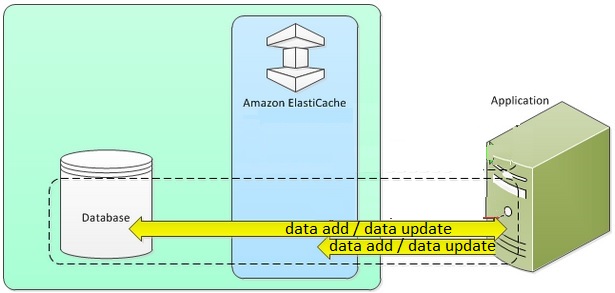Understanding AWS ElastiCache Caching Strategies: Lazy Loading vs. Write Through

When using AWS ElastiCache, several methods are available for populating your cache, known broadly as caching strategies. Understanding and choosing the optimal caching strategy is crucial because the best strategy for one application might not be ideal for another. For instance, the strategy that I would use for a gaming app that needs to maintain leaderboard data in near real-time might differ significantly from the strategy suited for an architecture involving multiple applications that require consistent login state maintenance.
AWS ElastiCache offers two primary caching strategies: Lazy Loading (also known as "cache aside") and Write Through. In this article, we’ll delve into these strategies, their advantages, disadvantages, and scenarios where they might be most appropriate.
Lazy Loading Strategy

Lazy Loading is a caching strategy where data is loaded into the cache only when necessary. Here’s how it works:
1. Cache Hit: When an application requests data, the cache is checked first.
- If the data is present and up-to-date (cache hit), ElastiCache returns the data to the application.
The process involves:
- The application requests data from the cache.
- The cache checks for the requested data's availability and currency.
- The requested data is returned to the application.
2. Cache Miss: If the data is not in the cache or has expired (cache miss):
- The application forwards the query to the database.
- The database returns the data directly to the application.
- The application updates the cache with the new data.
Advantages of Lazy Loading:
- Efficiency: Only the data that is needed gets cached, preventing the cache from filling with unnecessary data.
- Resilience: Node failures are non-fatal. If a cache node fails, it gets replaced, and the application can continue functioning by directly querying the database, albeit with increased latency.
Disadvantages of Lazy Loading:
- Cache Miss Penalty: Initial requests for uncached data incur a latency penalty since the application has to fetch data from the database.
- Stale Data: There's a risk of serving stale data if not managed properly, as the data in the cache might not always be the latest.
Write Through Strategy

Write Through is a caching strategy where data is updated in the cache as soon as it is written to the database. This synchronization ensures that the cache always holds the latest data.
1. When data is written to the database, it is simultaneously written to the cache.
2. The process ensures that data in the cache is never stale.
Advantages of Write Through:
- Up-to-date Data: Ensures that the cache always has the latest data, eliminating the risk of serving stale data.
- Consistency: Provides strong consistency between the cache and the database.
Disadvantages of Write Through:
- Write Penalty: Every data write involves two trips—one to the database and one to the cache—leading to increased latency.
- Cache Churn: Frequently updated or rarely accessed data can fill the cache quickly. This can be mitigated by using a Time-to-Live (TTL) strategy to evict old or unused data automatically.
Choosing the Right Strategy
Choosing the right caching strategy depends on your application's specific needs and constraints. Here are some considerations:
1. Tolerance to Stale Data:
- If your application cannot tolerate stale data (e.g., real-time analytics), Write Through is the better choice.
- If occasional staleness is acceptable, Lazy Loading can be more efficient.
2. Tolerance to Cache Node Failures:
- If your application needs to continue functioning seamlessly even when a cache node fails, **Lazy Loading** is preferable.
- Write Through ensures data consistency but can suffer from write latency issues.
3. Read vs. Write Performance:
- If read performance is critical and write operations are less frequent, Lazy Loading can provide better performance by reducing unnecessary writes to the cache.
- For applications with frequent write operations that must be reflected in the cache immediately, Write Through is more suitable.
Combining Strategies
These strategies are not mutually exclusive. Depending on the application's complexity, combining both strategies might be the optimal solution. For instance:
- Lazy Loading can be used for non-critical data where occasional staleness is acceptable.
- Write Through can be employed for critical data that needs to be immediately consistent.
Practical Applications
1. Gaming Applications:
- Lazy Loading can be effective for leaderboard data that updates frequently but doesn’t require instant consistency.
- Write Through can be used for user profile data where consistency is critical.
2. E-commerce Platforms:
- Lazy Loading can cache product catalog data, reducing database load and improving response times.
- Write Through can be used for inventory levels to ensure real-time availability status.
3. Web Applications:
- Lazy Loading can cache session data, improving performance and user experience.
- Write Through can ensure that user settings or preferences are always up-to-date.
Conclusion
AWS ElastiCache provides powerful caching strategies to enhance application performance and scalability. Understanding and implementing the appropriate caching strategy—whether Lazy Loading, Write Through, or a combination of both—can significantly impact your application’s efficiency and user experience. By carefully considering your application’s tolerance to stale data, cache node failures, and the read/write performance needs, you can choose the optimal strategy to meet your requirements.
Optimizing your caching strategy with AWS ElastiCache not only enhances performance but also ensures a resilient, scalable, and user-friendly application.
Happy Clouding !!!
Did you like this post?
If you did, please buy me coffee 😊